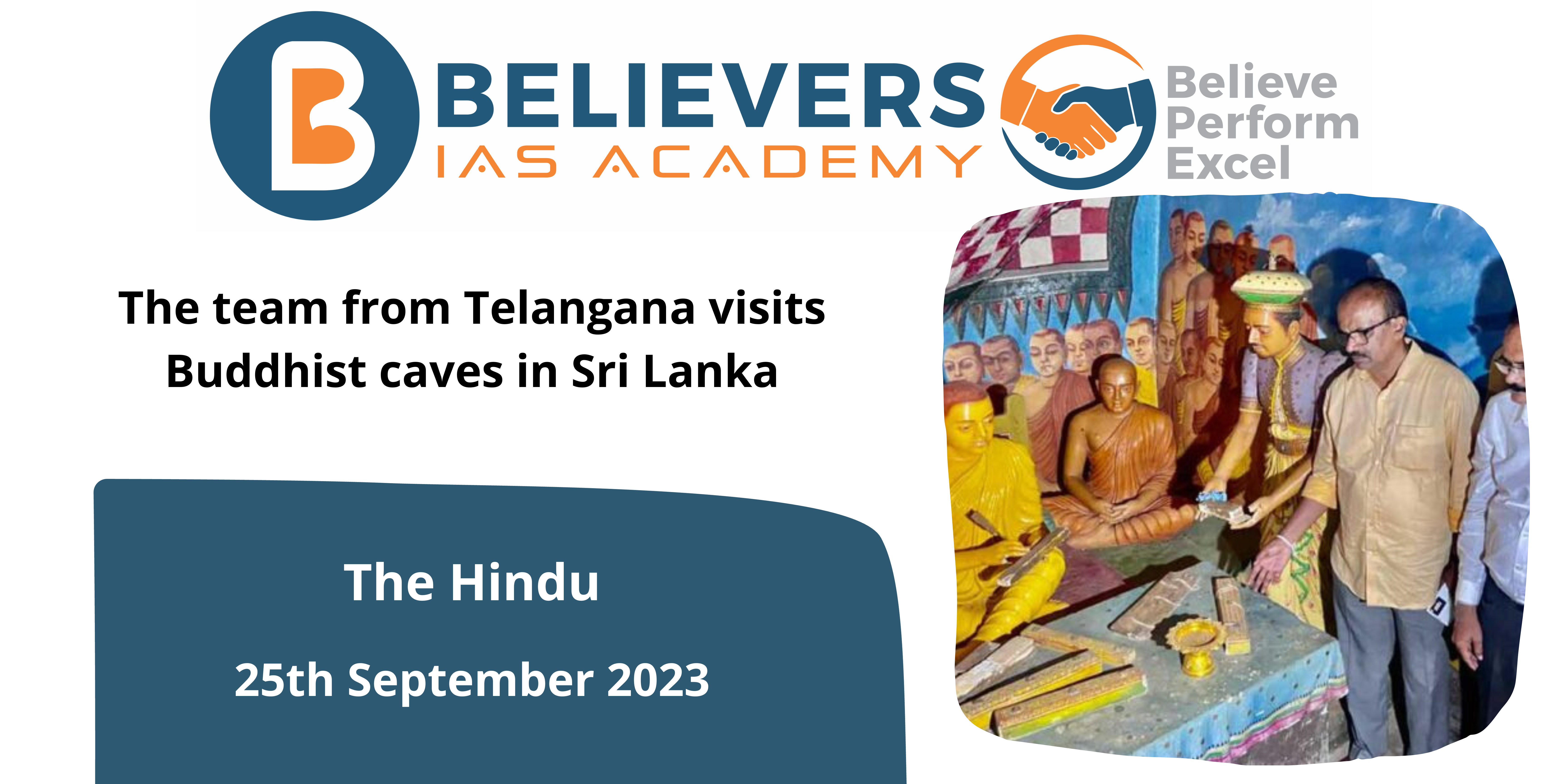The team from Telangana visits Buddhist caves in Sri Lanka
Context
On Sunday, a Buddhavanam team from Telangana toured the Buddhist rock-cut caverns at Mathale along the Colombo-Kandy highway in Sri Lanka. These caves date back to the third century BC.
What is the Buddhavanam Project?
- The Telangana government has undertaken a large project called Buddhavanam, which is situated in Nagarjunasagar on the northern bank of the River Krishna. This project was started to encourage tourism in the state and has been given the go-ahead by the Indian government. It is part of a larger initiative to create a comprehensive Buddhist Circuit, which is meant to draw both domestic and foreign visitors, especially those from Southeast Asia.
What are the features of the Project?
- Size and Purpose: At a whopping 279 acres, Buddhavanam is a sizable Buddhist history theme park. Being among the biggest of its sort, it stands out.
- Buddha’s Life: The main goal of Buddhavanam is to present many facets of the life of Gautama Buddha. The Entrance Plaza, Buddhacharitha Vanam (which depicts the life of Buddha), Jataka Park (which includes stories from the Jataka tales), Dhyana Vanam (a meditation area), Stupa Vanam (containing stupas), Maha Stupa, a large stupa, and an internal Buddhist Heritage Museum are some of the elements that are included in this.
- Complex Carvings: The drum and dome parts of the Mahastupa at Buddhavanam are decorated with complex carvings. In addition to having artistic value, these carvings provide tourists with a beautiful vista.
- Historical Background: Buddhavanam is close to Nagarjuna Sagar, a reservoir created by building a dam over the River Krishna. This region, formerly known as Nagarjuna Konda or Sriparvata-Vijayapuri, served as the Ikshvaku dynasty’s capital city between the third and fourth century A.D.
- Acharya Nagarjuna: Nagarjunakonda is named in honour of the illustrious Madhyamika philosopher and Buddhist scholar, Acharya Nagarjuna. This area served as a hub for Mahayana Buddhism and was home to numerous Buddhist sects, monasteries, shrines, and stupas that were devoted to spreading the teachings of Buddhism.
- Archaeological Findings: Between 1954 and 1960, extensive excavations at Nagarjunakonda uncovered several noteworthy structures. A Maha Stupa, Votive Stupas, Chaityas, Silamandapas, and various Buddhist sculptures and artefacts were among the discoveries. A palatial complex and a few brick-built Brahmanical temples were also uncovered.
- Preservation efforts: Many of these old buildings were in danger of being submerged because of the Nagarjunasagar reservoir. As a result, several buildings—including the Maha Stupa and sculptures—were rebuilt on Nagarjunakonda Island and at Anupu, a ferry stop on the River Krishna’s right bank.
- Museum: The holy relics of the Buddha are kept in the Island Museum on Nagarjunakonda Island, which also houses other found antiquities. Visitors can get an insight into the area’s extensive Buddhist heritage by viewing these artefacts and relics on display.
What is the significance of the caves that the team visited in Sri Lanka?
The Buddhist rock-cut caves at Mathale on the Colombo-Kandy route, which the Telangana team visited in Sri Lanka, are thought to date back to the third century BC. They are significant historical and cultural sites for various reasons.
- Historical Significance: These caverns are important since it is thought that they are where Lord Buddha’s teachings were initially recorded on palm leaves. An important development in the history of Buddhism was this occurrence, which signified the change from the oral to the written transmission of Buddhist teachings.
- Early Buddhist Literature: The Sutr, Vinaya, and Abhidhamma pikas, which make up the Tripitaka and are considered to be the primary texts of Buddhism, were recorded in the caves. The teachings and tenets of Buddhism were recorded in writing, enabling their transmission across generations and geographical boundaries.
- Acharya Buddhaghosha, a well-known Theravada Buddhist philosopher, is thought to have spent some time living in these caves and producing the influential Buddhist work Visuddhimagga. His presence here increases the caverns’ historical and academic significance.
- Cultural and Religious History: These caverns have great spiritual value for Buddhists and are a part of Sri Lanka’s cultural and religious history. They draw both local Buddhist devotees and travellers interested in Buddhism as they serve as locations for prayer, meditation, and pilgrimage.
- Buddhist Connection: The caverns offer proof of Sri Lanka’s long-standing historical and cultural ties to Buddhism, which is an important part of the nation’s identity and legacy. They highlight Sri Lanka’s contribution to the preservation and spread of Buddhist teachings.
- Value in terms of archaeology: The rock-cut caverns and the artefacts retrieved from the neighbourhood shed light on Sri Lanka’s ancient Buddhist civilization’s contacts with India.
Conclusion
In conclusion, Buddhavanam is an amazing initiative by the Telangana government to honour and preserve the Buddhist legacy of the region, highlighting the life of Gautama Buddha and the historical importance of Nagarjunakonda. Visitors and tourists have a rare chance to discover and gain knowledge of the rich cultural and historical connections between Buddhism and this area.




